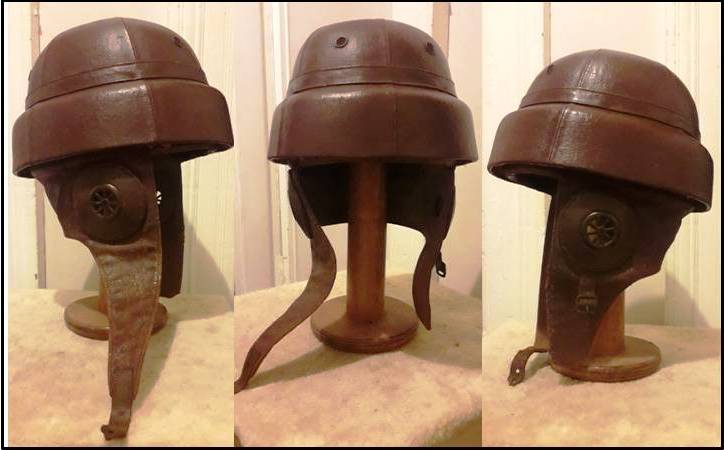 Figure 1. Contemporary documents point to Curtis’s 1916, 2nd patent the ‘Improved “Warren” Safety Helmet’ being the best candidate for the identity of the 1920-1924 RAF listed ‘Helmet, Aviation’ 22C/12. The term ‘Helmets, Aviation’ had been on RFC lists since 1914 and it would seem the term was even then applied to protective helmets of a similar type. The cork structure and the use of vent collets over the ears would imply these helmets were made in the same workshops as sun helmets (images courtesy of Judith Mclay).
Figure 1. Contemporary documents point to Curtis’s 1916, 2nd patent the ‘Improved “Warren” Safety Helmet’ being the best candidate for the identity of the 1920-1924 RAF listed ‘Helmet, Aviation’ 22C/12. The term ‘Helmets, Aviation’ had been on RFC lists since 1914 and it would seem the term was even then applied to protective helmets of a similar type. The cork structure and the use of vent collets over the ears would imply these helmets were made in the same workshops as sun helmets (images courtesy of Judith Mclay).
In RAF flying clothing lists from the early 1920s there are three forms of head gear included; 22C/5 ‘Caps, Fur Lined’; 22C/12 ‘Helmets, Aviation’ and 22C/13 ‘Helmets, Cork Aviation’. The identity of the first and the last are self-explanatory and unambiguous; 22C/12 ‘Helmet, Aviation’ has, however, caused some confusion.
Figure 2. Top: Although a unified RAF Nomenclature had been worked on since late 1917, this is thought to be the first and only published edition of the ‘Provisional Vocabulary of Stores for the Royal Air Force’, document ‘F.S.133’, (May 1920). Cover and page 343 – the 22-C Section, ‘Flying Clothing’. Here the list is alphabetically ordered in clothing type, with reference numbering actually in sequence. This is possibly the list as it appeared when compiled at the setting-up of the RAF in 1918. The F.S. appellation stands for ‘Field Service’; a British Army series of publications, here apparently a vestige from RFC days. It has received a post printing ‘Air Publication No.’ ink stamp to bring it in line with other RAF/Air Ministry publications. It is clear that there was a distinction between ‘Caps’ and ‘Helmets’; the former soft, the latter hard. 22C/5 ‘Caps, fur-lined’ are here labeled as ‘summer’. Under ‘Helmets’ are listed two types; 22C/12 ‘Aviation’ and 22C/13 ‘Cork, aviation’. Bottom Left: page 410 of Air Publication 809 ‘Priced Vocabulary of Royal Air Force Equipment and Meteorological Stores’, first edition 1921. It uses the Nomenclature set out in F.S.133. It was amended and up-dated numerous times until A.P. 1068 took over in October 1924. It is still arranged in clothing type with Ref. Nos now getting out of sequence, as subsequent items have to be fitted into the Nomenclature’s clothing type framework. Right: The first edition of ‘Air Publication 1068; Priced Vocabulary of Royal Air Force Equipment’, giving prices for equipment replacement from October 1924 to November 1927, note 22C/12 was always substantially more expensive than both 22C/5 and 22C/13. The ‘n’ that now appears after 22c/12 ‘Helmets—Aviation’ (a name that had been on RFC lists since at least 1914) indicates ‘obsolescent and that no further purchases will be made…should be exhausted by issuing in preference to stocks of a more improved pattern…’
Figure 3. The earliest available list of RFC clothing, 1914 – ‘Regulations – Clothing of the Army’, the Royal Flying Corps section (in Table III). The ‘Helmet, Aviation’ is the only headwear mentioned, with 25 issued ‘Per Aeroplane Squadron’ and 50 supplied to the Central Flying School. It would appear that even at this early date it was seen as primarily a training helmet, and would imply it was a ‘Protective’ helmet. At this time only the ‘Roold’ and ‘Improved “Warren” Safety Helmet’ had been adopted as War Office ‘Sealed Patterns’ (Cormack & Cormack, 2001) and probably both were encompassed by the term ‘Helmets, Aviation’ in this 1914 list, as they both did the same job.
When the RFC and Royal Naval Air Service (RNAS) amalgamated in 1918 a unifying ‘Nomenclature’ was produced (O’Hara (2005) & Stone (2017)) and an item called ‘Helmets, Aviation’ was included and by May 1920 at least, was given the Section/Reference number 22C/12. This item was declared ‘Obsolescent’ in 1924.
22C/5 ‘Caps, Fur-Lined’ were listed until the late 1920s when replaced by the ‘1930 Pattern’ 22C/51; 22C/13 ‘Helmets, Cork Aviation’ were listed until early WWII, when it actually picked up a further series of 22C numbers 274-284 denoting the eleven sizes then available, but it was soon to be replaced by the Type-D Tropical Helmet in 1942, 22C/969-972.
It should be noted that RFC, RNAS and RAF official documents from WWI and then through the 1920s as well as trade advertising make a clear distinction between soft ‘caps’ and the hard ‘helmets’ – see here for trade advertising.
By the 1930s however, the term ‘helmet’ was applied to both soft and hard flying headwear; this may have lead to the confusion.
22C/12 ‘Helmets, Aviation’ have variously been identified as either a ‘Summer’ or a ‘Winter’ version of 22C/5, depending on which of these ‘22C/5s’ is thought to be by various authors, however, the May 1920 document F.S. 133 (Figure 2) states that 22C/5 was in fact the ‘Summer’ version of Fur-lined Caps; it is thought the winter version of the Fur-Lined Cap may have been the Cowl Type (Cormack & Cormack, 2001), which was obsolete by the time section/reference numbers were applied, due to the shoulder-length design hindering easy turning of the head.
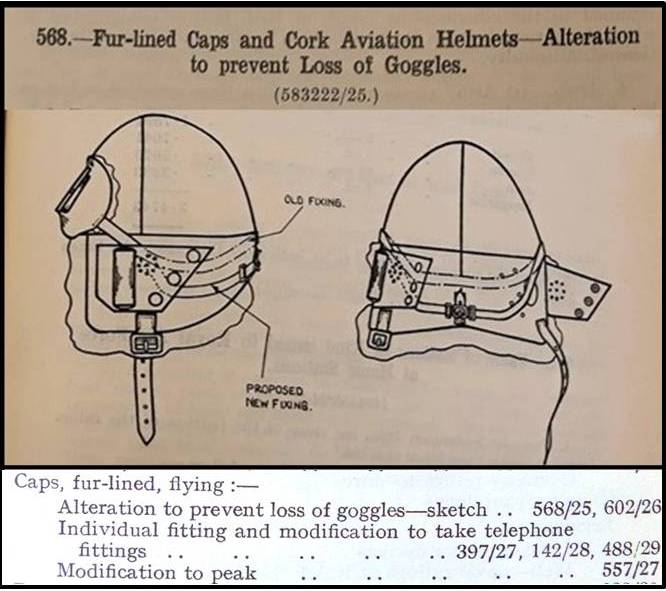 Figure 4. Top: shows a sketch from a 1925 Air Ministry Weekly Orders (AMWO 568/1925)) and shows unambiguously the identity of 22C/5 ‘Fur-lined Cap’, which were being modified in various ways throughout this period.
Figure 4. Top: shows a sketch from a 1925 Air Ministry Weekly Orders (AMWO 568/1925)) and shows unambiguously the identity of 22C/5 ‘Fur-lined Cap’, which were being modified in various ways throughout this period.
Figure 4. Bottom: It has been suggested also that 22C/12 was one of several Telephony/Oxygen mask adaptations of flying caps experimented with and used in late WWI and the immediate post-war years (Fig. 5). However, primary sources such as AMWOs, Air Ministry correspondence (‘Design of Combined Helmet and Mask for use with Wireless Telephony and Oxygen’ 1917-1918) and Royal Aircraft Establishment (RAE) reports (‘Experimental wireless telephone helmet’, 1924) show that these adaptations were always seen as modified caps with separately numbered components attached to them; a combination of items, rather than leading to an overarching new clothing section/reference number. Initially 7000 standard fur-lined caps where sought as a base to hold the combined parts, but at a 7th December 1917 conference, 200 commercial Dunhill caps were recommended to be procured as a stop-gap measure. The trend of combing parts continued into the 1930s, e.g. the ‘1930 Pattern’, 22C/51 and the ‘Type-B’, 22C/65 were issued without ‘ear holes’; holes were cut by tailors to match individual airman’s ears, they were then built up as ‘telephony helmets’. As an example ‘AMO A207 ‘Receivers, Telephone – Instructions for fitting to Caps, Flying (1930 Pattern), (Stores Ref. 22C/51)’ gives instructions on how to combine the 22C/51 cap with several 10A = ‘miscellaneous radio equipment’ items, i.e. the helmet was always known as 22C/51 with various 10A pieces added.
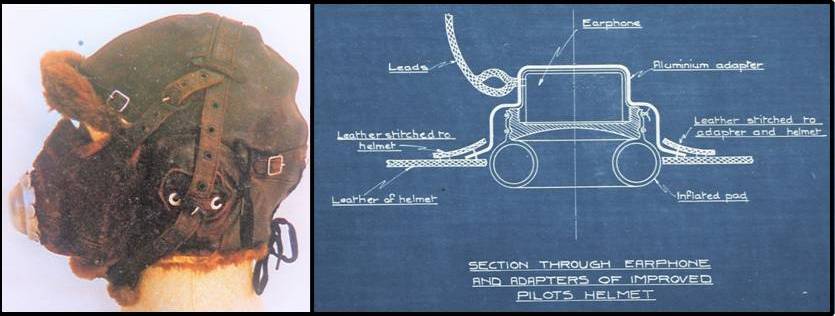 Figure 5. Left: a period Telephony/Oxygen combination of the Fur-Lined Cap. Such combinations started to be developed and used from 1917 and were in continued development in the post war years. However, AWMO lists, Air Ministry correspondence and RAE reports all point to their not receiving separate Section/Reference numbers, but were considered experimental and usually referred to by their component parts. Right: a detail of the 1924 RAE Report, K.1865, showing how components were to be sewn to a standard 22C/5 fur-lined cap. (Left image from Prodger, 1996).
Figure 5. Left: a period Telephony/Oxygen combination of the Fur-Lined Cap. Such combinations started to be developed and used from 1917 and were in continued development in the post war years. However, AWMO lists, Air Ministry correspondence and RAE reports all point to their not receiving separate Section/Reference numbers, but were considered experimental and usually referred to by their component parts. Right: a detail of the 1924 RAE Report, K.1865, showing how components were to be sewn to a standard 22C/5 fur-lined cap. (Left image from Prodger, 1996).
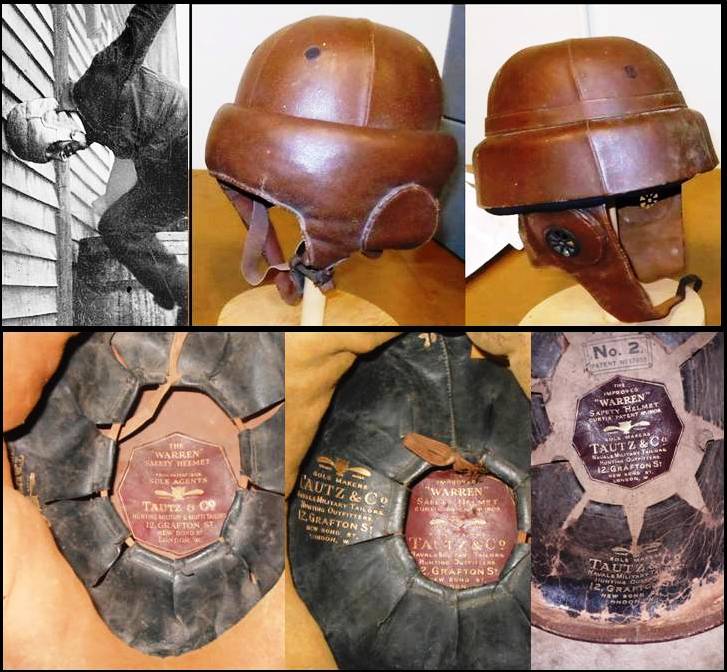 Figure 6. Top left: Mr W. T. Warren in 1912 demonstrates the impact absorbing properties of his original ‘Warren Patented Safety Helmet’. Top centre: both Warren’s original and Curtis’ 1914 first patent ‘Improved “Warren” Safety Helmet’ had well-padded surfaces and both looked similar. Top right: in 1916 Curtis modified the design again, this time deleting the horsehair padding and using a simple 2-3 inch thick foam rubber ring around the brim, leading to the No. 2 patent. Bottom left to right: the inside of‘The “Warren” Safety Helmet’ as sold by Tautz in early 1914, basically Warren’s 1912 design, the August 1914 patent ‘The Improved “Warren Safety Helmet’, still well padded, but oval to conform to the head better. The No.2 Patent ‘The Improved “Warren Safety Helmet’, now lacking the thick soft padding. (Images, top two at right and bottom two at left Ewen Cameron. Bottom right, Judith Mclay)
Figure 6. Top left: Mr W. T. Warren in 1912 demonstrates the impact absorbing properties of his original ‘Warren Patented Safety Helmet’. Top centre: both Warren’s original and Curtis’ 1914 first patent ‘Improved “Warren” Safety Helmet’ had well-padded surfaces and both looked similar. Top right: in 1916 Curtis modified the design again, this time deleting the horsehair padding and using a simple 2-3 inch thick foam rubber ring around the brim, leading to the No. 2 patent. Bottom left to right: the inside of‘The “Warren” Safety Helmet’ as sold by Tautz in early 1914, basically Warren’s 1912 design, the August 1914 patent ‘The Improved “Warren Safety Helmet’, still well padded, but oval to conform to the head better. The No.2 Patent ‘The Improved “Warren Safety Helmet’, now lacking the thick soft padding. (Images, top two at right and bottom two at left Ewen Cameron. Bottom right, Judith Mclay)
It can be seen that later Warren Safety Helmets can have a confusing amount of labeling inside them. The reason for this complexity is that in 1912 Mr. W.T. Warren invented a safety helmet, he used a ‘Roold’ (a 1910 French design) like padded cork shell, but attached to the inside of the cork were sprung steel strips forming a dome attached to a small disc inside the crown and a round metal band at the brim (see Fig. 8, left). At this time there was mounting concern about the shocking accident and fatality rates due to unregulated flying and internationally moves were being made to improve its safety (e.g. ‘To Make Flying Safe’, Literary Digest, Oct. 5, 1912). Warren is reported to have patented the idea early that year, although the patent number and details are elusive. In 1912 Warren’s design was marketed by ‘Aeros, Ltd’ (also trading as ‘Aeronautical Accessories’), 39 St. James Street, Piccadilly, London, who were the sole agent for ‘The Warren Patent Safety Helmet’. By mid-1913, however, it appears ‘W. T. Warren, Ferndale, Mount Rd., Hendon’, was selling the helmet himself. But then by July 1914 it appears Warren had sold the rights of the patent to Tautz & Co; a Naval & Military tailor in London, who then became sole agents. Initially they sold the standard ‘Warren Patent Safety Helmet’, but by December 1914 they were advertising the ‘Improved “Warren” Safety Helmet’ a redesign lodged by the Proprietor Mr. C. H. Curtis of the ‘tailor and breeches maker’ Tautz & Co., this was patented as ‘Improvements in Helmets for Aviators and the like’ No. 19109, August, 1914.
 Figure 7. A 23rd December 1914 advertisement for The ‘Improved “Warren” Safety Helmet’, Curtis’s first patent. By this time being ‘supplied to the War Office and Admiralty’. According to Cormack & Cormack (2001) it had been accepted as a War Office ‘Sealed Pattern’ (No 8115), August 1914. See here for advertisements.
Figure 7. A 23rd December 1914 advertisement for The ‘Improved “Warren” Safety Helmet’, Curtis’s first patent. By this time being ‘supplied to the War Office and Admiralty’. According to Cormack & Cormack (2001) it had been accepted as a War Office ‘Sealed Pattern’ (No 8115), August 1914. See here for advertisements.
It mainly involved making the helmet oval shaped in plan-view rather than round, adjusting the sprung steel strip lengths to accord to the oval form and improving the internal padding and straps. Because the helmet type was synonymous with the name ‘Warren’ it continued to carry that name though-out its lifetime. Warren’s original design and the first ‘improvement’ by Curtis, were both well padded inside and out with horsehair under a leather or oilcloth cover, internally this was to protect the head from the metal frame. In December 1916, however, Curtis again submitted to the Patent Office further ‘Improvements to Helmets for Aviators & the like’, this time making the outer surface much neater, removing the outer padding, apart from a 2-3 inch ring of foam rubber around the brim, all covered by tight leather or oilcloth over the cork. This made it almost indistinguishable from the ‘Roold’ type at a distance, but it still kept Warren’s internal steel sprung dome. This patent was granted August 1917, it was called the No. 2 Patent, ‘Improved “Warren” Safety Helmet’. The last dated commercial advertisement found showing a ‘Warren’ helmet is a general Tautz & Co one from 18 October 1918.
So in fact there were three versions; first Warren’s 1912 original design, ‘The Warren Patent Safety Helmet’ (sold in turn by three different ‘agents’), secondly Curtis’s ‘Improved “Warren” Safety Helmet’, very similar in appearance to Warren’s original, and thirdly the No. 2 ‘Improved “Warren” Safety Helmet’, externally very different in appearance; they did however all retain the internal metal springing and the same chestnut brown colour. As such labeling wise it had become complex by 1916-17, the name Tautz & Co, the patent owners by this time, was prominent, but so was Warren’s and Curtis’s names. Adding to the ‘credits’ were various manufactures stamps, including Christys, Hobson and Owens; Tautz & Co by this time were farming the manufacturing out, which would imply many were being produced to fill contracts for the War Office and Admiralty.
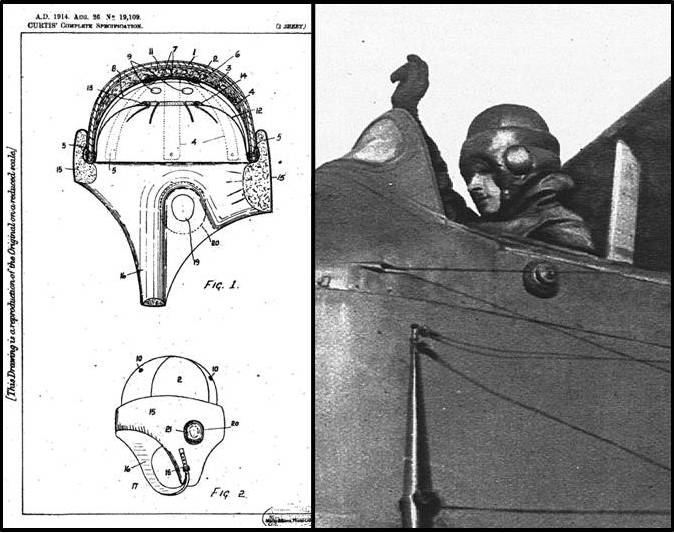 Figure 8. Left: Diagram from Curtis’s first patent application August, 1914, slightly modifying Warren’s original 1912 design, it was made a War Office ‘Sealed Pattern’ at the same time (Cormack & Cormack, 2001). Warren’s sprung steel strips can be seen (4) riveted (6) to a small ‘circular or oval plate’ (7) in the crown and a metal band (5) inside the rim. At right: a trainee at the Central Flying School in 1916, perhaps wearing one of the ‘50’ sent there in 1914 as mentioned in ‘Regulations – Clothing of the Army’ (see Fig. 3).
Figure 8. Left: Diagram from Curtis’s first patent application August, 1914, slightly modifying Warren’s original 1912 design, it was made a War Office ‘Sealed Pattern’ at the same time (Cormack & Cormack, 2001). Warren’s sprung steel strips can be seen (4) riveted (6) to a small ‘circular or oval plate’ (7) in the crown and a metal band (5) inside the rim. At right: a trainee at the Central Flying School in 1916, perhaps wearing one of the ‘50’ sent there in 1914 as mentioned in ‘Regulations – Clothing of the Army’ (see Fig. 3).
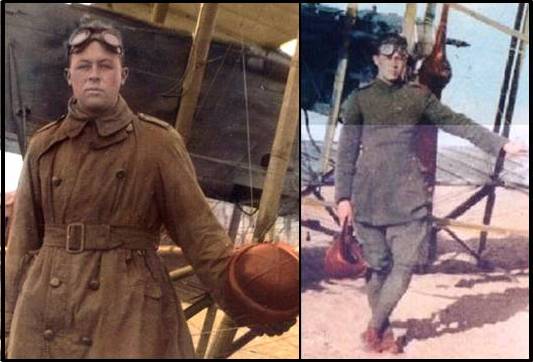 Figure 9. Royal Flying Corps Flying School in Ismailia, Egypt. Konrad Johannesson, Left: after his first solo flight, 21st January, 1918, holding a No. 2 Patent, ‘Improved “Warren” Safety Helmet’, and wearing obsolete RFC 1st Pattern goggles. Right: February 1918, he is holding an earlier padded Warren Safety Helmet. (Both images are details from Brian Johanneson’s collection.)
Figure 9. Royal Flying Corps Flying School in Ismailia, Egypt. Konrad Johannesson, Left: after his first solo flight, 21st January, 1918, holding a No. 2 Patent, ‘Improved “Warren” Safety Helmet’, and wearing obsolete RFC 1st Pattern goggles. Right: February 1918, he is holding an earlier padded Warren Safety Helmet. (Both images are details from Brian Johanneson’s collection.)
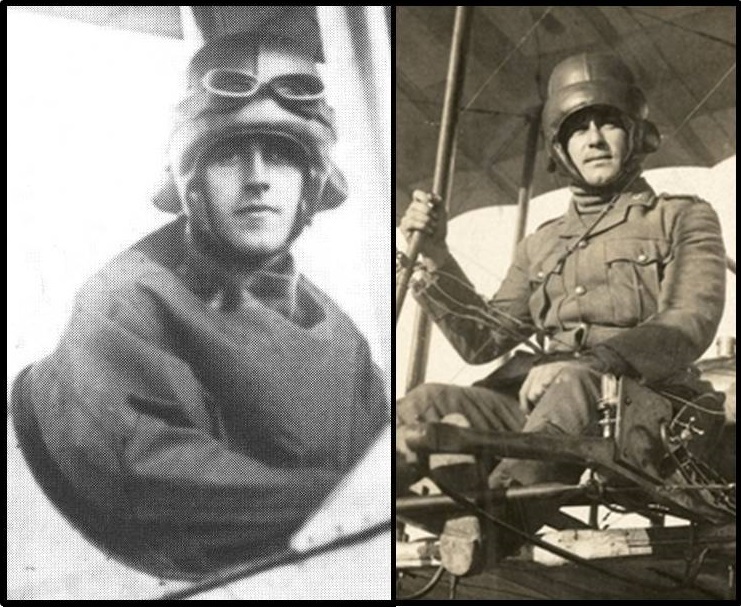 Figure 10. Left: Well known portrait of Henry Petre at Australia’s Point Cooke, Central Flying School in mid-1914. He had been brought to Australia two years earlier to help establish an Australian Flying Corps and is probably wearing an original pre-war/pre-Tautz ‘Warren Patent Safety Helmet’. Right: one of the school’s pupils Lt. Roy Trout, in 1916. His precarious sitting position illustrates the need for crash helmets in the early days.
Figure 10. Left: Well known portrait of Henry Petre at Australia’s Point Cooke, Central Flying School in mid-1914. He had been brought to Australia two years earlier to help establish an Australian Flying Corps and is probably wearing an original pre-war/pre-Tautz ‘Warren Patent Safety Helmet’. Right: one of the school’s pupils Lt. Roy Trout, in 1916. His precarious sitting position illustrates the need for crash helmets in the early days.
In tandem with these commercial happenings both the RNAS and RFC made extensive use of hard protective helmets in the early years, having accepted for issue, and sealed as official patterns both the French ‘Roold Helmet’ (Patterns Room of the War Office, ‘Sealed Pattern’ No. 8061, May 1914) and then, probably for patriotic and supply reasons, WWI having started, the first Curtis patented ‘Improved “Warren” Safety Helmet’ ,War Office ‘Sealed Pattern’ No 8115, August 1914, (Cormack and Cormack, 2001). These Sealed Patterns, kept at the War Office, were normally an example of the physical object with a label attached. The label was marked with a wax seal, (hence the name sealed pattern) and dated with the earliest date of issue, they could be resealed at later dates if the pattern remained in use after revisions. Dates of resealing were also recorded on the label. Once the pattern was obsolete the label was stamped “Obsolete” with the relevant date, (Belinda Day (Nat. Army Museum), 2020, personal communications). As well as the ‘Type Examples’ kept at the Patterns Room, copies were made available to potential manufacturers.
As can be seen in Fig. 3 the only item of RFC headwear mentioned in the 1914 ‘Regulations – Clothing of the Army’ is ‘Helmet – Aviation’ a term which probably encompassed both the Roold and Warren helmets ‘Sealed’ by the War Office earlier that year (N.B. the first soft leather ‘caps, fur-lined’ were sealed as a ‘temporary’ pattern in November, 1914, and do not appear on the 1914 list, they were probably seen as cheap private purchase items so were not officially issued by the War Office until May 1915 (Sealed Pattern, 8402, ‘caps, leather’, with several revisions by war’s end). This ‘dual procurement’ of a French and a British type protective helmet seems to have been addressed in the Autumn of 1916 when the No. 2 patent ‘Improved, “Warren” Safety Helmet’, Curtis’s type, with a tight Roold type leather or oil-cloth cover over cork, was registered in the War Office Pattern Room as ‘Helmet, Aviation’, Sealed Pattern No. 9276 (Cormack & Cormack, 2001).
So it seems the RFC in 1914 was procuring both the Roold and the Warren safety helmet and these were the ‘Helmet, Aviation’ listed in the 1914 RFC list. By 1916 it seems the best characteristics of the Roold and the Warren were combined in the No. 2 Patent ‘Warren’. This is documented as having been sealed by the War Office as ‘Helmet, Aviation’ late 1916 (Cormack & Cormack, 2001), the actual commercial patent was not finally granted to this model until 9 August 1917.
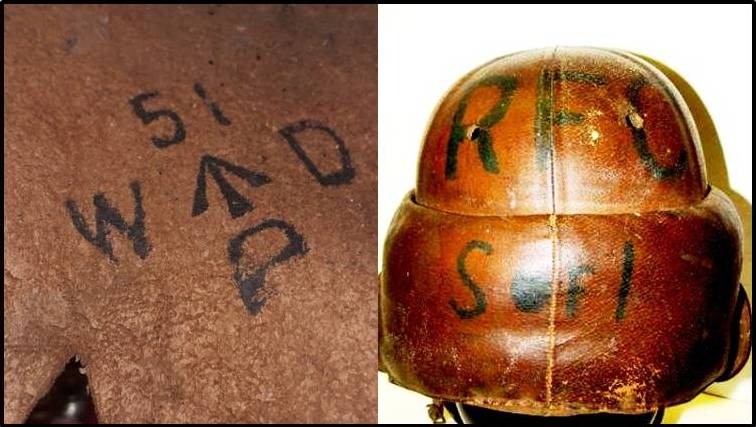 Figure 11. At left, a standard WD property mark in the helmet shown in Fig. 1, these are commonly found under the leather headband of Warren helmets. At right a less standard RFC ‘property mark’; (‘S of I’ = School of Instruction? Reading?).
Figure 11. At left, a standard WD property mark in the helmet shown in Fig. 1, these are commonly found under the leather headband of Warren helmets. At right a less standard RFC ‘property mark’; (‘S of I’ = School of Instruction? Reading?).
It would seem unlikely that the term ‘Helmet, Aviation’, (or ‘Helmets for Aviators and the like’), which all in the RFC, RNAS and early RAF would have associated with these early crash helmets would suddenly have been applied to a totally different type of headwear when the 22C system was introduced sometime during the 18 months following WWI. It was no longer thought useful for front-line service due to its bulk and its interference with peripheral vision, but as it had always been, it was still being used in training schools.
Figure 12. The three pieces of headwear listed in the first RAF Nomenclature. Early lists make clear there was a distinction between soft ‘caps’ and hard ‘helmets’. 22C/5 were ‘caps, fur lined’ (initially called the ‘summer’ type, but this was soon dropped as the Cowl Type ‘caps, fur-lined, winter’ had already become obsolete) and adaptations thereof, i.e. flannel lined versions; those with modified peaks (AMWO 557/27) and various ‘telephony’ modifications (397/27 &etc), all were still referred to as 22C/5 – but with modifications. The ‘Helmets, cork aviation’, are unambiguously the tropical helmet 22C/13. However 22C/12, code name ‘SDYBJ’ in 1921, ‘Helmet, Aviation’ since 1914 has become confused, but it is clear that the No. 2 Patent Curtis ‘Improved “Warren” Safety Helmet’ was officially sealed as ‘Helmet, Aviation’ (Pattern No. 9276) in 1916. Here is shown a typical WD owned Warren safety helmet. Very similar helmets had been on the books since 1914, known to all as ‘Helmets, Aviation’ and these were still being issued to training establishment in the last years of the War; exactly during the time the vocabularies were being written. The Armistice would have severely curtailed the need for trainee helmets and aircraft were becoming safer, as such these protective helmets were made obsolescent in 1924. Although rare today the Warren was almost certainly the mysterious 22C/12 – ‘Helmet, Aviation’.
Steve Saunders, March 2020
Acknowledgements
I thank the staff of The British Library (Social Sciences Enquires and Asian and African Studies Enquires); The National Archives, Kew; the Royal Air Force Museum, London, (especially Ewen Cameron and Andrew Dennis), the National Army Museum (Belinda Day) and IWM, Duxford (William Martin) for their help in tracking down various obscure primary documents and items from my often vague and evolving requests.
References (Chronological order)
- ‘To Make Flying Safe’. Literary Digest, 5th October,1912. (http://www.oldmagazinearticles.com/1912_Aviation_Invention_Article#.XmbK5XIzaUk)
- ‘Improvement in Helmets for Aviators and the like.’ 1914-15. Patent No. 19109. (espacenet.com)
- ‘Regulations for the Clothing of the Army’, 1914, Royal Flying Corps Section, Table III (pages 94-95). Published by the War Office. (British Library)
- ‘Improvement in Helmets for Aviators & the like.’ 1916-17. Patent No. 108419. (espacenet.com)
- ‘Design of Combined Helmet and Mask for use with Wireless Telephony and Oxygen’, 1917-1918. Air Ministry Communications. (AIR 2/96/D5813 of the National Archives)
- ‘Provisional Vocabulary of Stores for the Royal Air Force’, Field Service (F.S.) 133 (post publication corrected by ink stamp to ‘Air Publication 133’), May 1920. (RAF Museum)
- ‘Priced Vocabulary of Royal Air Force Equipment and Meteorological Stores’, Air Publication 809; 1921 Edition. (National Archives)
- ‘Experimental wireless telephone helmet’, 1924. Royal Aircraft Establishment Report K.1865 (AVIA 6/4297 of the National Archives)
- ‘A Priced Vocabulary of Royal Air Force Equipment’, Air Publication 1086, 1 Oct. 1924. (British Library)
- ‘Fur-Lined Caps and Cork Aviation Helmets—Alteration to prevent Loss of Goggles.’ Air Ministry Weekly Orders 583222/1925. 568. (British Library)
- ‘A Priced Vocabulary of Royal Air Force Equipment’, Air Publication 1086, 1 Oct. 1927. (British Library)
- ‘Index to Air Ministry Weekly Orders. 20th March, 1918, to 31st December, 1930. With List of Cancelled Orders’. In – a volume of Air Ministry Weekly Orders for 1930, held by the British Library, Indian Office Records (IOR/L/17/10/323).
- Prodger (1995). ‘Vintage Flying Helmets, Aviation Headgear Before The Jet Age’. Schiffer Publishing Ltd.
- Cormack and Cormck (2001). ‘British Air Forces 1914-18’. Osprey Books.
- O’Hara (2005). ‘The Early Days’. Royal Air Force Historical Society, Journal 35 (Seminar – Supply – An Air Power Enabler).
- Rood (2014). ‘A Brief History of Flying Clothing’. Journal of Aeronautical History. Paper No. 2014/01
- Stone (2017). ‘Sustaining Air Power: Royal Air Force Logistics since 1918’. Fonthill Media
- https://www.aviationancestry.co.uk/ e.g. searches for Warren; Tautz; flying helmets etc.
- https://www.rareaviationphotos.com/ , a variety of images taken by and of Konrad Johannesson.

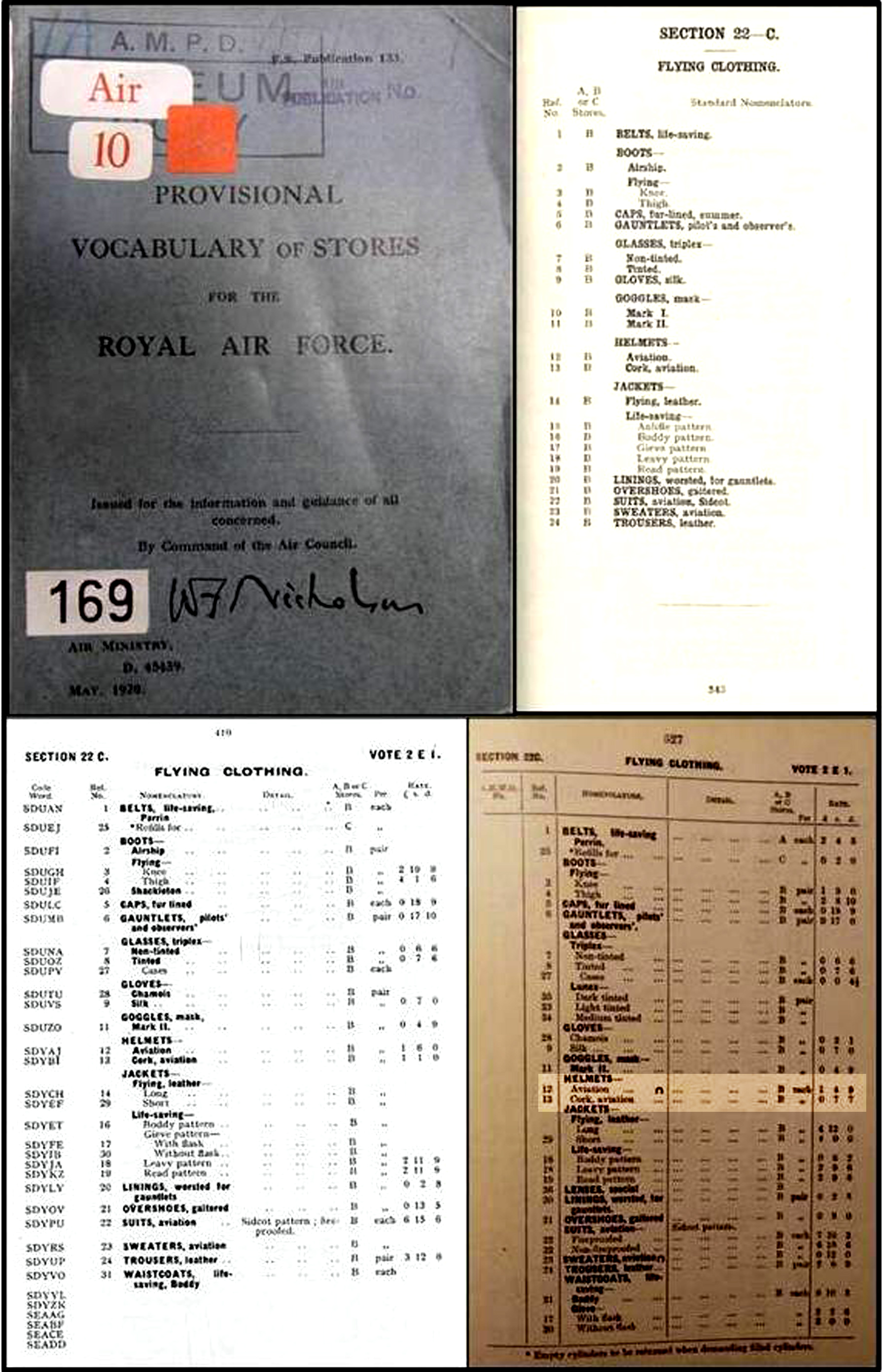
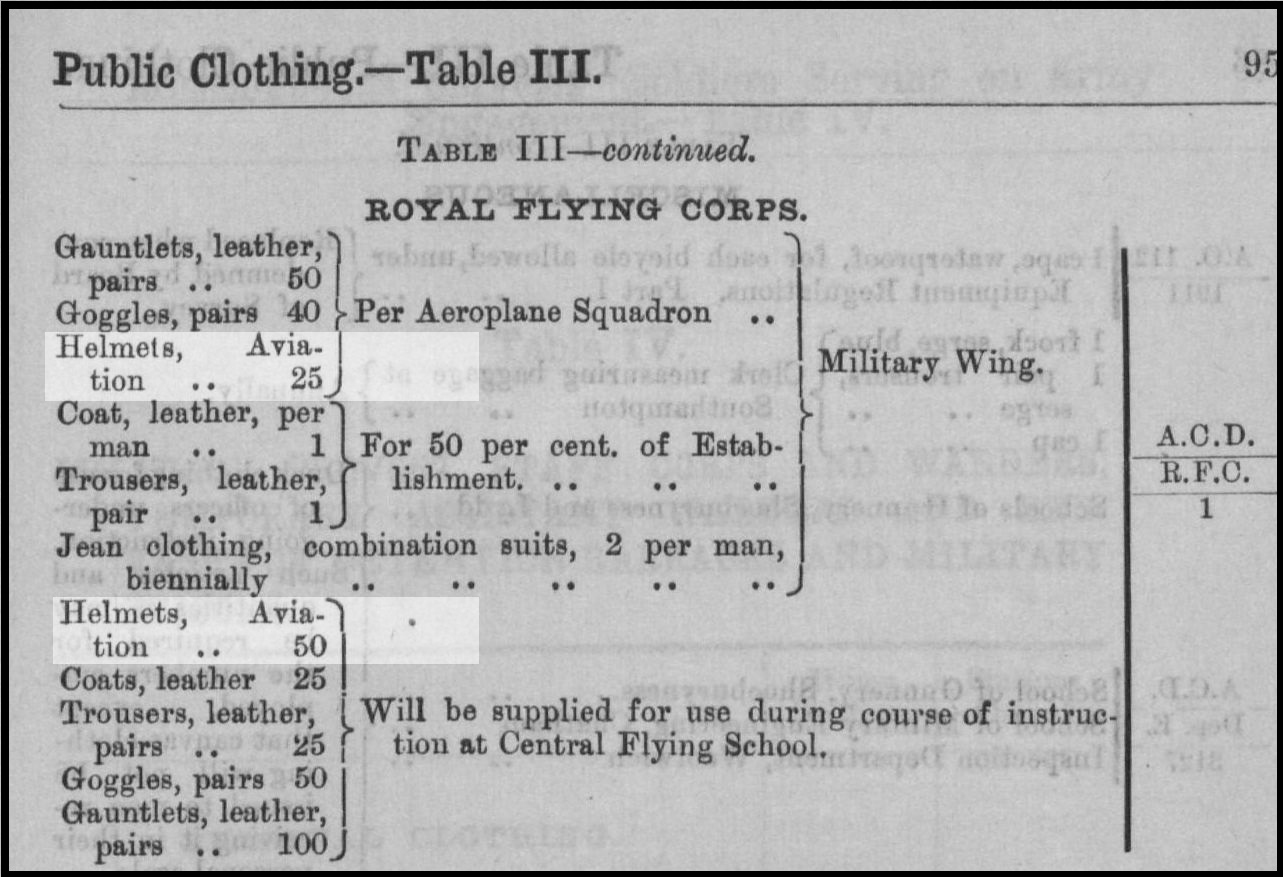

Re. The Mystery RAF Helmet ‘Helmet, Aviation’ 22C/12
Dear Steve,
I am very greatly impressed with the quality of your commentary regarding the aviation headgear that forms the subject of this page. It is unusually objective and draws on primary source material and not the fiction and myth so characteristic of more recent, secondary sources. It is all the more impressive that its subject, aviation headgear, might not be your main area of interest – certainly the name of the website, http://www.militarysunhelmets.com/ suggests that it is not.
Aviation headgear – or British flying kit 1918-1945 – is though my own particular interest., and I have recently reached a firs draft of my own work in this field – at some 550,000 words.
I am greatly intrigued by the blue print from and your references to ‘1924 RAE Report, K.1865’, and would very much like to see a copy of that Report. Are you able (and willing!) to provide me with a copy of your copy?
With thanks, and looking forward to hearing from you,
Graham Potts,
The Aircrew Collection
Hi Graham,
I’m happy to. Have sent it and some similar documents via ‘normal’ email.
Regards
Steve